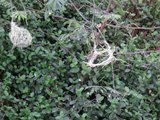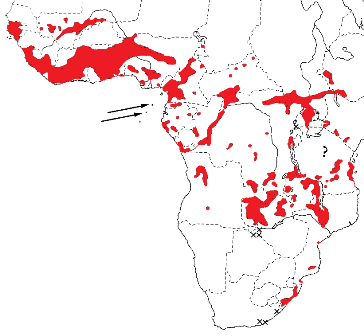Weaver species
Choose different species from drop-down list and press 'Go' button. See Full species list.Red-headed Quelea Quelea erythrops
IUCN: Least concern Discovery: 049Categories: Quelea, pest, blue eggs,
News items about species
Discovery
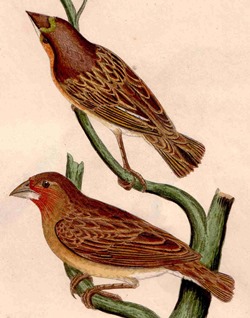
figure from Hartlaub 1850 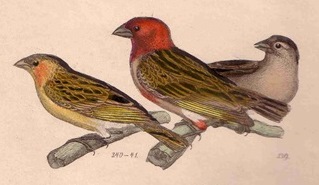
figure from Reichenbach 1863 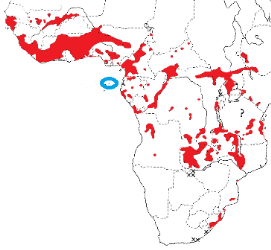
distribution, type locality circled IntroductionThe Red-headed Quelea was formally described by Karel Johan Gustav Hartlaub, a German physician and ornithologist.Carl Weiss, a German collector, was the first person to obtain specimens of the Red-headed Quelea (together with other bird specimens, including the Sao Tome Weaver) for The Hamburg Museum. He travelled from 1847-1850 on the ship Adolphus to Sao Tome then to the coast of Ghana, to Principe and back to Sao Tome again. He probably collected the Red-headed Quelea soon after arriving on the island, and sent back many bird specimens which Hartlaub was able to describe in 1848 and later. The first illustration of a Red-headed Quelea is a colour painting published by Hartlaub in 1850. The second illustration was published by Reichenbach 1863. Scientific citationPloceus erythrops Hartlaub 1848 Rev. Zool. 1848 p.109 Sao Tome.Meaning of nameserythrops - Greek. Eruthros, red; ops, the eye, the face; refers to the red or rufous face.First English nameThe red-headed Dioch (Reichenbach 1863).Alternate namesPokerhead, Red-headed Dioch, Red-headed Weaver.CollectorCarl Weiss.Date collected1847.Locality collectedSao Tome Island.Type specimensOne type specimen is in the Zoological Museum at the University of Hamburg, and specimen UMB - 5281 is in Ubersee Museum Bremen. |
The above is based on Weaver Wednesday 2, a weekly series about the discovery of each weaver species.
This species text first appeared as
Weaver Wednesday [166] - Discovery [49]: Red-headed Quelea on 2015-08-19
1. Basic biology
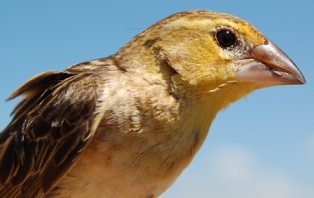
adult female 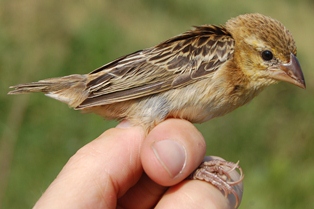
juv 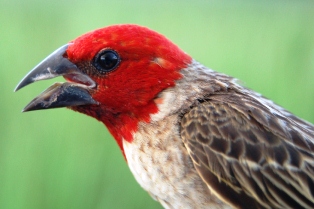
adult male Identification. The Red-headed Quelea is a small weaver found in scattered localities through Africa. The male in breeding plumage has a bright red head, closely resembling the Cardinal Quelea but the Red-headed Quelea has the red of its head continuing onto the nape but not onto the breast, and has black barring on the throat. The female is very similar to the female Cardinal Quelea, with a yellowish face and supercilium, but has a white throat, short dark moustachial mark, slightly larger and paler bill, but is probably not safely distinguishable in the field. The non-breeding male may retain some red on the head. Read more about its identification in South Africa here.
Distribution. The Red-headed Quelea occurs widely through sub-Saharan Africa (see map left, based on Birds of Africa). Two races have been proposed previously, Q. e. erythrops in the north and Q. e. viniceps in the south, but the species is currently treated as monotypic. Morphological differences between these races are slight, but there may be differences in the timing of moult, migrations and breeding in the two regions which suggests separation with minimal interchange between these populations. Habitat. The Red-headed Quelea inhabits rank grass near water, tall grassland, farmland and rice fields. It is highly gregarious, often in flocks of over 1000. Small groups join mixed-species flocks of weavers. Flocks are restless, some birds feeding on the ground, and others perching in bushes. Food. The diet of the Red-headed Quelea consists of grass seeds, and insects. Rice is taken, and it may be a pest in some areas. Nestlings are fed on insects. Breeding. The Red-headed Quelea is probably polygynous. It is colonial, with several hundred nests close together. The largest colonies consist of 3000-5000 nests. Breeding is highly synchronized. Males may leave the colony before the young fledge. Colonies are seldom at the same site in successive years.
Eggs (1-4) are uniform pale blue. Incubation is by the female and clutches usually hatch in tightly synchrony in a colony. Movements. This species is migratory but few recaptures or recoveries have been reported. The greatest movement to date is at least 475 km and the details of this record may be seen here. |
The above is based on Weaver Wednesday, a weekly series about weaver species.
This species text first appeared as
Weaver Wednesday [49]: Red-headed Quelea on 2013-02-22
2. Breeding facts
| Pair bond Probably polygynous, males building up to three nests simultaneously Breeding season mainly Jun-Oct in W Africa, Nov-Feb on Sao Tome; Jul-Aug in Sudan and N Congo Basin, Jan-Mar in S DRCongo, Apr in Uganda and Apr-May in Tanzania; Jan-Apr in Angola, Zambia and Malawi; usually Dec-Jan in S Africa but egg-laying recorded early Mar in Zimbabwe Nest site suspended c. 1.5 m above ground or over water between grass or reed stems Nest building Nest built by male Colony size with hundreds or thousands of nests per colony Clutch size 1-4 eggs, average 2 (South Africa) Egg colour pale blue Egg size average size for 38 eggs in South Africa 19.4 x 13.5 mm Incubation incubation by female only, period, c. 13 days at Zimbabwe colony, captivity 12-14 days Chicks and nestling period chicks fed generally by female only, at one colony males also seen to feed, nestling period 12-14 days |
Breeding information based on Handbook of the Birds of the World, Vol. 15.
3. Photos of Weaver Nests
 Vm 12099 |  Vm 12089 |  Vm 5344 |  Vm 18 |
Thumb-nails of most recent PHOWN records - click on one to see its full record
See all PHOWN records for this species here.
PHOWN (Photos of Weaver Nests) provides valuable info on breeding distribution and colony sizes of weavers.
You can contribute by registering and submitting photos at Virtual Museum webpage.
4. Breeding distribution
Google map showing distribution (For species with small ranges you need to zoom in at the correct area to see the range):
yellow blob - range of weaver species; read more about this here.
![]() - PHOWN records with photos
- PHOWN records with photos
![]() - PHOWN records with no photos (Nest Record Cards, other records)
- PHOWN records with no photos (Nest Record Cards, other records)
![]() - Birdpix records
- Birdpix records
![]() - comments on out of range records, or interesting records
- comments on out of range records, or interesting records
![]() - type locality
- type locality
CLICK on the marker on the map to see individual record details.
5. Range changes
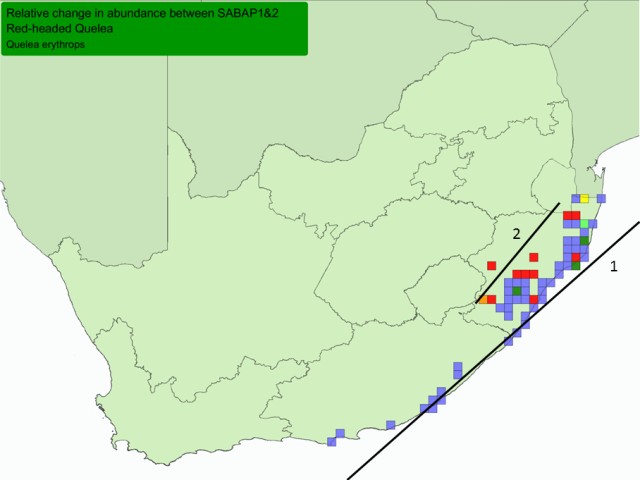
Red, orange and yellow = cells with very large, large, and small relative decreases Blue, dark green and light green = cells with very large, large and small relative increases. Cells = quarter-degree grid cells; Only cells with at least 4 checklists in both SABAP1&2 shown. All cells had this species recorded in SABAP1 or in SABAP2 or in both (more about interpretation at Biodiversity Observations 7.62: 1-13).
Range changes in SA
The points below match the points on the map above. Areas with very large increases include:
Areas with very large decreases include:
The Red-headed Quelea occurs at a low density in southern Africa. During SABAP1 the Red-headed Quelea was not recorded in the Eastern Cape, but there had been many records prior to SABAP1. Range changes elsewhereBotswana: new arrival (Tyler 2008a).Chad: seen near Mongo, unusually far north (Demey 2015b). | |||||||||||||||||||||||||||||||||||
The above is based on Weaver Wednesday 3, a weekly series about range changes in South African weaver species.
This species text first appeared as
Weaver Wednesday 3 [254] - Range changes [17]: Red-headed Quelea on 2017-04-26








